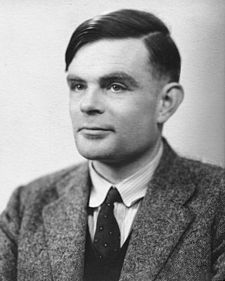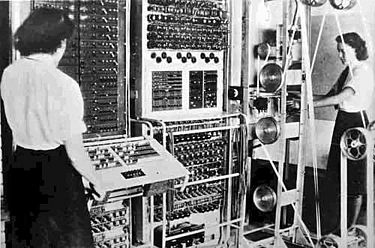

Statue of Turing by Stephen Kettle at Bletchley Park, commissioned by the American philanthropist Sidney Frank.[60]

The technology was bought by Nuance Communications (known then as ScanSoft) and Vantage Learning after the bankruptcy. Nuance acquired all of the speech technologies and Vantage acquired all of the proofing, spelling, and linguistic search technologies.
The L&H technologies proved to be very valuable. "Lernout & Hauspie Michelle" and "Lernout & Hauspie Michael" are text-to-speech voices created by Lernout and Hauspie and included in Microsoft Office 2003. Lernout and Hauspie speech recognition is now used in the "Speech" option in the control panel of Microsoft Windows XP and is abbreviated as LH. In addition, Microsoft Office uses certain elements of a grammar checker developed by L&H, which is mentioned in the About window. The revenues of Nuance Communications grew sharply from $17.1 million in third quarter of 2001, to $216 million in Q3 2008.[6]
In 1981 I helped my friend Dale Crouse build his computers on my
dining room table. These were telephone exchange type of machines which
generated their own billing.
Crime and Punishment Journal
Dale's "computers" were shoe-box sized machines which utilized the existing WATS lines and a network which was being built between some American Universities. They enabled calling across the country, and in between networks within cities like Seattle.
A four-node network emerged on December 5, 1969 between the University of California, Los Angeles, the Stanford Research Institute, the University of Utah and the University of California, Santa Barbara. This network would become ARPANET, which by 1981 would consist of 213 nodes.[19] In June 1973, the first non-US node was added to the network belonging to Norway's NORSAR project. This was shortly followed by a node in London.[20]
In North American telecommunications, Wide Area Telephone Service (WATS) was a flat-rate long distance service offering for customer dial-type telecommunications between a given customer phone (also known as a "station") and stations within specified geographic rate areas employing a single telephone line between the customer location and the serving central office. Each access line could be arranged for outward (OUT-WATS) or inward (IN-WATS) service, or both.[1]
Journal of Crime & Punishment 6th May 2014
When the computer first became "sentient" or conscious, is anybody's guess. Some people say it is still not true or possible in a realistic sense. It is my belief that it happened in the 1980's with the growth of the bigger mainframes, and then the advent of the internet, and the use of web cameras, enabling computers to see as well as talk to each other. It is only possible if a language enables it, but a computer may well be able to comprehend, even if it cannot, or chooses not to communicate with humans. Alan Turing may well have believed that his computer Colossus was able tounderstand him, and could its own reasoning ability to solve problems, without being specifically programmed to calculate a problem.
Although he looks unremarkable, Alan Turing was a genius to whom the whole world owes a deep debt of gratitude. He was however punished for his homosexuality, and prevent from working. His test for a machine's ability to exhibit intelligent behaviour, (think) is called the Turing Test. You can now run this test yourself using AIML software from http://alice.pandorabots.com/

http://en.wikipedia.org/wiki/Category:Early_computers
The category of early computers contains the computer systems made in the early era (i.e., the era in modern computer history defined as the period from the late 1930s to the early 1960s) utilizing mechanical, vacuum tube, discrete transistor, or other pre-integrated circuit technology.
Colossus was the world's first electronic digital computer that was at all programmable. The Colossus computers were developed for British codebreakers during World War II to help in the cryptanalysis of the Lorenz cipher.
Colossus was the world's first electronic digital computer that was at all programmable. The Colossus computers were developed for British codebreakers during World War II to help in the cryptanalysis of the Lorenz cipher. Without them, the Allies would have been deprived of the very valuable military intelligence that was obtained

Alan Mathison Turing, OBE, FRS; 23 June 1912 – 7 June 1954) was a British mathematician, logician, cryptanalyst, computer scientist and philosopher. He was highly influential in the development of computer science, providing a formalisation of the concepts of "algorithm" and "computation" with the Turing machine, which can be considered a model of a general purpose computer.[2][3][4] Turing is widely considered to be the father of theoretical computer science and artificial intelligence.[5]
The test was introduced by Alan Turing in his 1950 paper "Computing Machinery and Intelligence," which opens with the words: "I propose to consider the question, 'Can machines think?'" Because "thinking" is difficult to define, Turing chooses to "replace the question by another, which is closely related to it and is expressed in relatively unambiguous words."[3] Turing's new question is: "Are there imaginable digital computers which would do well in the imitation game?"[4] This question, Turing believed, is one that can actually be answered. In the remainder of the paper, he argued against all the major objections to the proposition that "machines can think".[5]
In the years since 1950, the test has proven to be both highly influential and widely criticized, and it is an essential concept in the philosophy of artificial intelligence.[1][6]
Having clarified the question, Turing turned to answering it: he considered the following nine common objections, which include all the major arguments against artificial intelligence raised in the years since his paper was first published.[10]
- Theological Objection: This states that thinking is a function of man's immortal soul; therefore, a machine cannot think. "In attempting to construct such machines," wrote Turing, "we should not be irreverently usurping His power of creating souls, any more than we are in the procreation of children: rather we are, in either case, instruments of His will providing mansions for the souls that He creates."